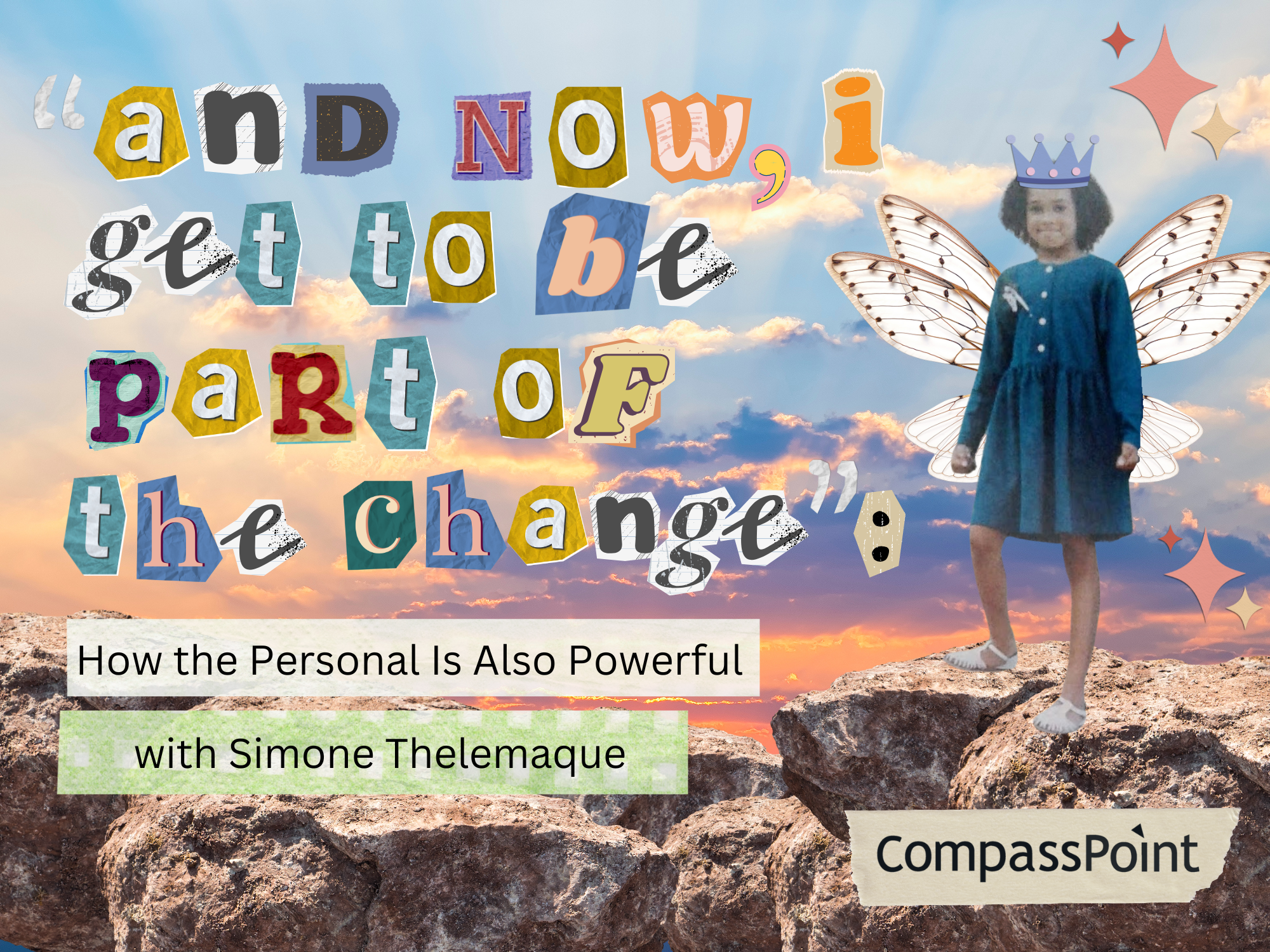What can you do when diversity efforts fall short within your organization? In this fiery opinion piece, CompassPoint Project Director Lupe Poblano challenges readers—white and people of color—to confront white dominant culture within your nonprofit as the best way to move your organization toward equity. Lupe also provides practical, real suggestions on steps you can take to initiate change.
Let me know if you’ve heard this one lately. Perhaps you are a part of a direct-service nonprofit that has a white dominant leadership structure—both demographically and culturally—despite the fact that most of the organization’s program work happens in black and brown communities. At some point, the white dominant leadership structure realizes, or has it pointed out to them, that “diversity” should be on their radar. The individuals within the leadership structure can’t fully articulate why having more people of color (POC) on the board or management team is important beyond the fact that it sounds good in theory and it looks bad in reality not to have more of it.
I mean, we’re in the Bay Area, right? On a nonprofit board of twenty, can’t we get more than one or two Latinxs on the board? And how is it that we have only one black or brown person on our eight-person management team?
When Well-Intentioned Efforts for Diversity Fall Short
The nonprofit makes some well-intentioned efforts. There’s lots of talk about recruitment, outreach, in-reach, and HR best practices. And yet, the efforts are predictably fruitless. Almost every time a position becomes available on the board or management team, the organization fills it with a white person—usually a well-educated, upper-to-middle-class white person. Besides reading a bunch of New York Times and Harvard Business Review articles on implicit bias, the white dominant leadership structure can’t figure out why attracting POCs into the leadership structure is proving so difficult.
My personal response to this quandary, as a POC, is pretty direct: you’ve got your head up your rear end on this. Instead of worrying about technical fixes to attract more POC into leadership positions, you need to focus your attention on the white people who currently hold power in your white dominant organization. In other words: before attempting the safe quick fixes to manufacture “diversity,” you might want to start by getting different white people.
Calling Out a White Dominant Culture
In order to create an environment where I, or other POC, are not tokenized in a leadership position, marginalized, or asked to be the “bridge” to communities of color (and the mostly POC program staff), I need a certain type of white person to share leadership with me. I need white people who spend a lot of time thinking about their own privilege, both individually and collectively. I also need a white board chair or white positional leader who will call other white leaders out on their white privilege, in the moment, to interrupt oppression as it happens. For instance, raise your hand if you’ve ever witnessed a POC program manager or director giving a report at a board meeting, only to have her or his story interrupted multiple times by white board members who think they know better. And raise your other hand if you’ve witnessed a POC staff member attempting to facilitate an internal meeting and soon facing a covert power struggle from white positional leaders over how the meeting is run. That’s privilege—that’s how it can show up, and that sh*t needs to be shut down before you think about adding more POC.
Furthermore, there needs to be organizational norms for how to name and deal with white fragility when it comes up (and believe me, it will and already does) during meetings and conversations. If the words white privilege or white fragility have never been uttered at any of your board or management team meetings, I can easily connect that data point with your organization’s inability to attract more POCs onto your boards and leadership teams.
Shifting the Power Paradigm
The second place to examine is your organization’s culture, and this is where both the POCs and white people who occupy structural leadership positions have a significant role to play. Hiring POC and asking them to conform to the dominant culture—the culture which usually does not value POC leadership traits—perpetuates inequity. Dominant culture tends to protect the institution (through HR policies and procedures and habits around financial transparency) that protect the status quo power structure. Generally speaking, dominant culture tends to focus on the individual, whereas communities of color are inclined to respect collective action. Dominant culture has a bias for productivity and efficiency; while many POCs come from cultures that value the whole person. Dominant culture elevates the formal written word and abstract thought as demonstrations of intelligence, which can marginalize POC who cannot (or choose not to) conform to this standard.
Without the above changes in existing personnel and culture, a white dominant leadership structure will never truly change, even if there are a few token POC additions to staff. Organizations that genuinely want profound change need to look in the mirror and not out the window. They need to do better than simply bring more POC into the leadership frame: the organization needs to begin centering leadership on POC. To do that effectively, individuals (both POC and whites) within white dominant leadership structure need to change the people already on the bus and transform the staff/board culture.
Additionally, there is a role—and an opportunity to look into the mirror—for us POC who currently occupy positions of leadership within some of the white dominant leadership structures. Our identities as POC do not prevent us from marginalizing each other. It is not our role to be the gatekeepers who decide to include or exclude others, and we have a role in interrupting oppression when we see it.
There are a few questions that help me examine my relationship to the power I have within these systems: what are the ways in which we as POC are invested in the dominant structures? How much power do these structures give us and why? And how do we share (or not share) that power with those who do not conform to the dominant culture? And what does that say about us? Specifically—what does that say about me?
In the end, if your board or management team has about the same number of POCs as a Tea Party meeting, it’s time to fundamentally change the way you do things. ALL leaders in the organization need to develop a critical analysis on race, class, power, and privilege. White leaders (and yes, even those on the board) need to locate their own cultural whiteness and become aware of how their internalized superiority shows up and how it negatively impacts POC inside their own organization. And we POC leaders should examine our internalized oppression and the ways we have conformed (or become invested in) the dominant leadership culture. Put bluntly, don’t seek to hire a few more POC and expect them to change you. You, leaders within the white dominant leadership structure, need to be willing to change you first.
If you take an honest look in the mirror and don’t like what you see, then you’ve got some work to do. Miss me with that.
Lupe Poblano, is co-director at CompassPoint. You can reach him by email. Follow him on twitter at @LupePoblano.
Looking to receive more blogs, news, and resources like this? Sign up for our newsletter here.
Read our series about centering justice and equity at CompassPoint:





Submit a comment
(2) Comments
Charmaine Ruddock replied on Permalink
While I appreciate the overall premise of this article, as a POC, I find the following two assertions demeaning and belittling as if POCs don't value productivity and efficiency or place a very high value on the formal written word and abstract thought. These are not just the province of white dominant culture....
Article: Dominant culture has a bias for productivity and efficiency; while many POCs come from cultures that value the whole person.
Me: it is not a binary choice between productivity and efficiency and valuing the whole person. One should value the whole person while still encouraging an individual and organizational culture of productivity and efficiency. The two are not mutually exclusive. Without both you will soon have a de-ceased organization.
Article: Dominant culture elevates the formal written word and abstract thought as demonstrations of intelligence, which can marginalize POC who cannot (or choose not to) conform to this standard.
Me: You are right, the inability to write formally should not be used to determine someone's intelligence, or lack thereof. We encounter too many people, whether in our personal lives or by some other means, who were not formally educated and cannot write formally but whose intelligence is formidable. That being said, one's ability to communicate ideas and concepts well in writing (and verbally) has historically been critical to any individual or organization's success. It is still a very, very powerful skill in the 21st century in any industry or sector even when we are communicating via social media. There maybe sectors or industries where this is not so but for the life of me I can't think of any.
Lupe Poblano replied on Permalink
Hi Charmaine – thanks for the critique and the opportunity to engage! Part of the harm from dominant culture, and white supremacy culture in particular, is that it reduces issues into mutually exclusive binaries and false dichotomies. I agree that we can hold the both/and of moving our collective work forward with momentum while still valuing whole people. You are totally right that we should not reduce this to a binary because it is absolutely not an either/or! And the intent around worshiping the written word (another element of white supremacy culture) is not at all to minimize the gift or the effectiveness of communicating ideas and concepts well in writing and verbally; rather, it was to elevate the value of other methods of communicating feelings and concepts (e.g. art, pictures, physical movement, physically building things together, breathing, etc.). Again, apologies for minimizing the value of ideas that are brilliantly communicated through words.